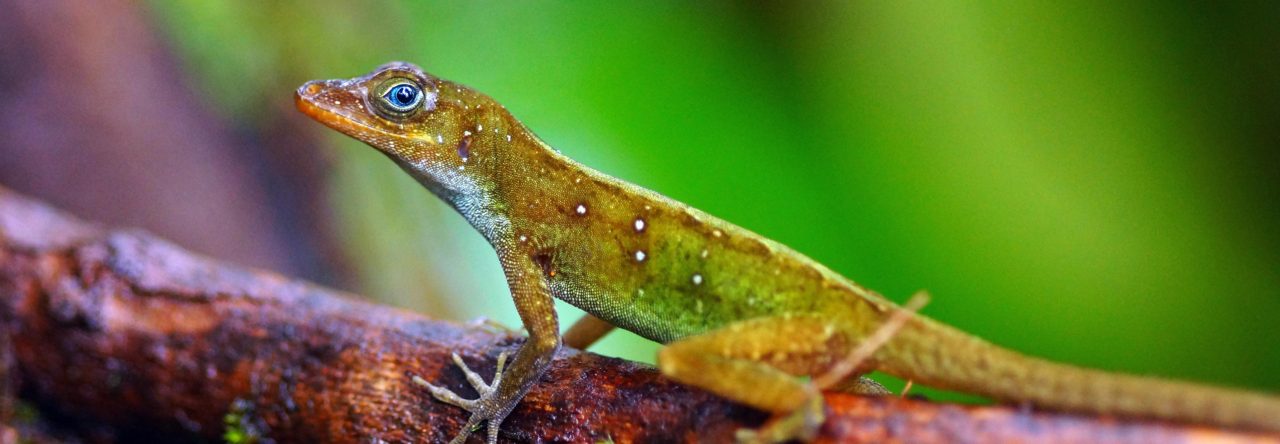In 2007 a multi-disciplinary group (Yasel U. Alfonso, Florida Museum of Natural History, USA; Lourdes Rodriquez-Schettino, Institute of Ecology and Systematics, Cuba; and Denis Dennis Avila, Faculty of Biology, University of Havana, Cuba) began to investigate phenotypic plasticity in three Anolis jubar subspecies. We quantified variation in meristic traits, head shape, microhabitat use (i.e, escape behavior, thermoregulation, feeding) and dewlap colour to see if any of these characters differs at a geographic, and subspecies level.  We analyzed variations on body dimensions and head shape (using geometric morphometrics) and their relationships with microhabitat use and found that A.j.albertscwartzi was the most differentiated subspecies (manuscript in prep.). Interestingly, Cadiz et. al. recently found Anolis jubar albertschwartzi to be more closely to Anolis homolechis than other A. jubar subspecies based on markers. The differences between our findings and genetic studies by Cadiz et al. (2013) highlight the need for a better understanding of how selective traits are shaped by speciation and selective forces.
We analyzed variations on body dimensions and head shape (using geometric morphometrics) and their relationships with microhabitat use and found that A.j.albertscwartzi was the most differentiated subspecies (manuscript in prep.). Interestingly, Cadiz et. al. recently found Anolis jubar albertschwartzi to be more closely to Anolis homolechis than other A. jubar subspecies based on markers. The differences between our findings and genetic studies by Cadiz et al. (2013) highlight the need for a better understanding of how selective traits are shaped by speciation and selective forces.
For the last few years, our multi-disciplinary group included two new members (Humberto J. Morris, Center of Studies for Industrial Biotechnology, Cuba; and John E. Steffen, School of Science, Penn State Behrend, PA) and we have been investigating pigment patterns in anoles from Eastern Cuba. Our first approach was analyzing the dewlap colour variation among three Anolis jubar subspecies (A.j.oriens, A.j.maisiensis, and A.j.albertscwartzi) using two alternative methods: 1) digitally, using RGB analyses with Munsell’s colour system (manuscript in prep.) and 2) spectrophotometrically, using pigment concentration variation to analyze subspecies level variation in dewlap colors (manuscript available in Copeia, 2013 issue 2, “Dewlap Color Variation Based on Pterin and Carotenoid Pigments in Three Subspecies of Anolis jubar of the Cuban Southern Coast”).
This research was made throughout fall 2008 and fall 2009, and we focused on quantifying the subspecies-level flexibility in dewlap pigmentation using only biochemical compounds from dewlap skin. We found that Anolis jubar albertschwartzi was the most differentiated subspecies based on pigment concentration (see details, Fig. 1 & 2) giving a light yellow shade of his dewlap coloration. 
We are performing similar pigmentary studies on several other Eastern Cuba anoles (e.g., A. allogus, A. rubribarbus, A. sagrei, A. porcus, A. anfiloquioi, A. cyanopleurus) and results will be available soon (manuscript in prep.).

In addition, I am leading other ongoing projects. One will attempt to explain relationships between color production and immune system health. Because pterins can also be synthesized by nonintegumentary tissues, most notably by immune cells (e.g. monocytes, macrophages), they may illustrate a critical link between color production and immunity in a colour-signalling system.
Finally, we’re analyzing anti-predator escape behavior, microhabitat use, and thermoregulation of anoles species on the semiarid southern coast (i.e., Guantanamo) (manuscript in prep.). All of these projects will keep us busy during next year.





















